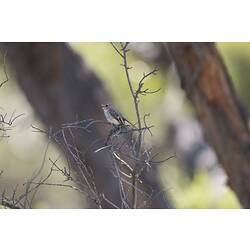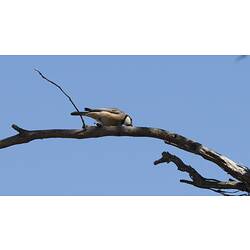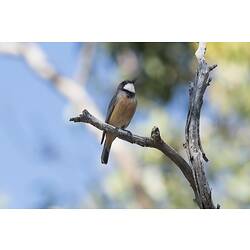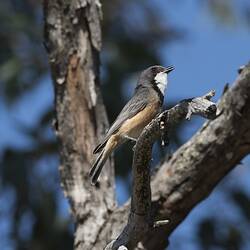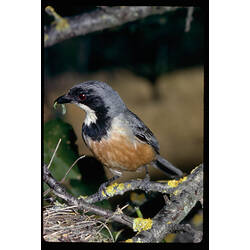General Description
Male: upper body dark grey with a black band from the face to the upper breast surrounding a white throat; underparts orange-brown (rufous). Can also have a black face. Female: upper body dull grey, underparts and throat yellow-brown (buff) with dark brown streaks. Tail long and slightly forked. The bill to tail length is up to 17 cm.
Biology
Male Rufous Whistlers sing when breeding to advertise their territory. They form monogamous pairs and both parents incubate the eggs and care for the young. Females attach their fragile, cup-shaped nests to tree forks with spider webs. Two clutches can be produced during the breeding season. They mainly eat insects but also occasionally eat leaves, seeds and fruit. Rufous Whistlers are rarely seen on the ground, typically foraging higher in the canopy than other whistlers. They tend to be solitary but can be spotted foraging with other species during the non-breeding season. Their song is very musical, containing a variety of trills, whistles and repeated whip-cracks.
Distribution
Pacific Islands. Mainland Australia.
Habitat
Forests, woodlands and urban areas.
More Information
-
Animal Type
-
Animal SubType
-
Brief Id
A stocky songbird with a white throat and orange-brown underparts.
-
Colours
Brown, White
-
Maximum Size
17 cm
-
Habitats
Wetland, Urban, DryForest, WetForest, Woodland, Mallee, Grassland
-
Diet
Insects
-
Endemicity
-
Commercial
No
-
Conservation Statuses
CITES: Not listed, FFG Threatened List: Not listed, EPBC Act 1999: Not listed, IUCN Red List: Least Concern
-
Taxon Name
-
Common Name
Rufous Whistler
-
Kingdom
-
Phylum
-
Subphylum
-
Class
-
Order
-
Family
-
Genus
-
Species Name
rufiventris







